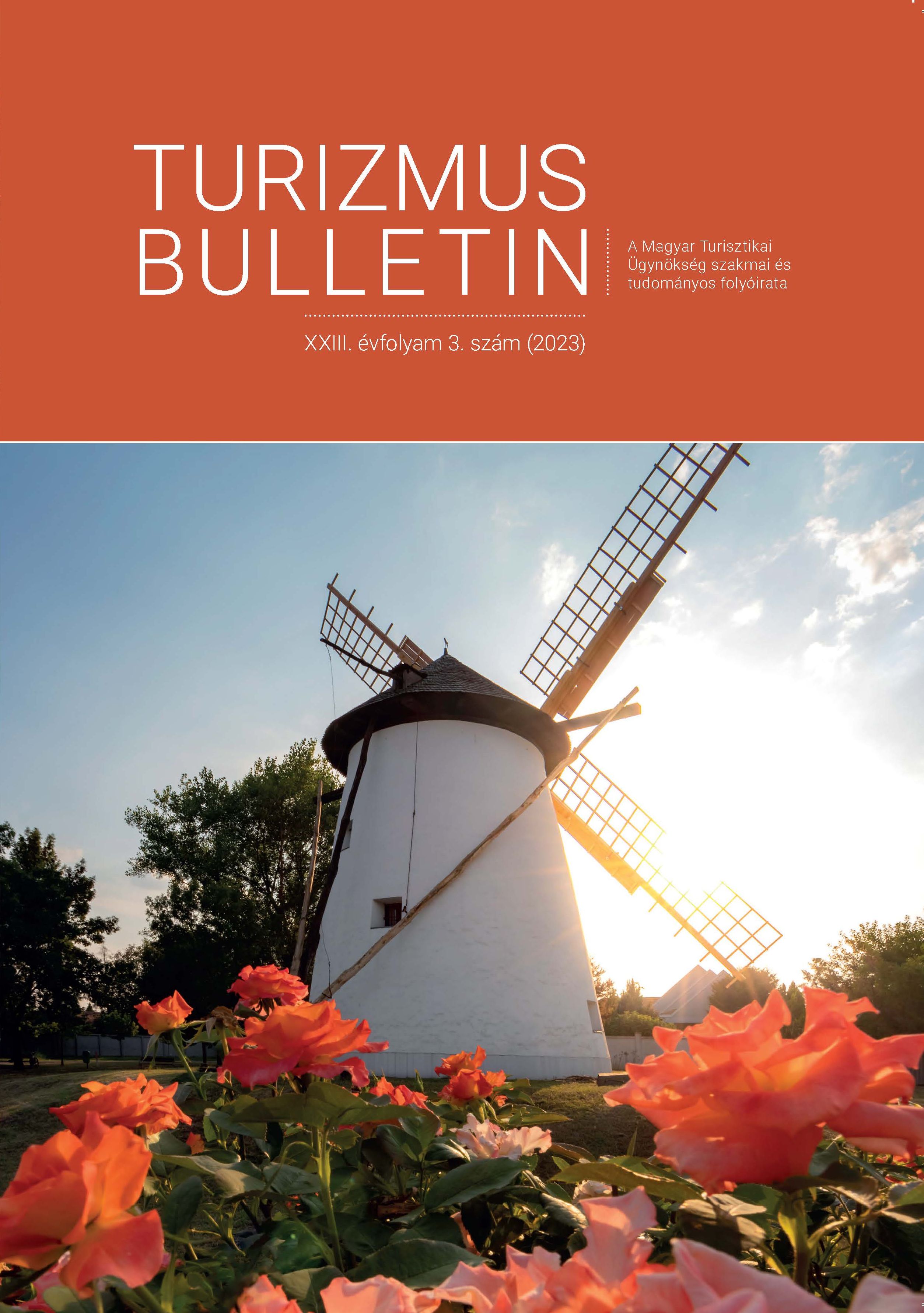What needs to be considered when designing co-created tourism products? The case of Budapest
DOI:
https://doi.org/10.14267/TURBULL.2023v23n3.5Keywords:
tourism co-creation, city branding, cultural tourism, sustainable tourismAbstract
This study examines the concepts of place-branding, wellbeing and identity in the context of the place-branding of Budapest, as well as their direct impact on sustainable tourism. The authors emphasize the importance of involving local stakeholders in creating an authentic place-brand, and they address various challenges related to tourism in the capital city, including overtourism and communication deficiencies. The authors specifically highlight the traditional thermal culture of Budapest as a potential collaboratively developed selling proposition for urban tourism. Consequently, a co-created selling proposition (CCSP) is recommended, involving businesses, civil organizations and tourism authorities to showcase the local cultural heritage of thermal baths. The study concludes that further research is needed on the relationships between tourism, wellbeing, and the services of the cultural ecosystem.
References
ASHWORTH, A. (2006): Four Threats to the Presumption of Innocence. International Journal of Evidence and Proof. 10(4). pp. 241–278. https:// doi.org/10.1350/ijep.10.4.241
BRAUN, V. – CLARKE, V. (2006): Using thematic analysis in psychology. Qualitative Research in Psychology. 3(2). pp. 77–101. https://doi. org/10.1191/1478088706qp063oa
BRAUN, E. – ESHUIS, J. – KLIJN E. H. – ZENKER, S. (2018): Improving place reputation: Do an open place brand process and an identity-image match pay off? Cities. 80. pp. 22–28. https://doi. org/10.1016/j.cities.2017.06.010
BREGOLI, I. (2012): Effects of DMO Coordination on Destination Brand Identity: A MixedMethod Study on the City of Edinburgh. Journal of Travel Research. 52(2). pp. 212–224. https://doi. org/10.1177/0047287512461566
CAMATTI, N. – WALLINGTON, S. (2022): Cocreation and internal place branding: a case study of Plettenberg Bay, South Africa. Place Branding and Public Diplomacy. https://doi. org/10.1057/s41254-022-00279-x
CAMPELO, A. – AITKEN, R. – THYNE, M. – GNOTH, J. (2014): Sense of Place: The Importance for Destination Branding. Journal of Travel Research. 53(2). pp. 154–166. https://doi. org/10.1177/0047287513496474
CRESWELL, J. W. (2013): Qualitative inquiry and research design. Thousand Oaks, California, USA.
JÁSZBERÉNYI M. – BOROS K. – MISKOLCZI M. (2022): Vonzerőfejlesztés a kulturális és aktív turizmusban. Budapest: Akadémiai Kiadó. https://doi.org/10.1556/9789634548041
KALANDIDES, A. (2011): The problem with spatial identity: revisiting the “sense of place”. Journal of Place Management and Development. 4. pp. 28– 39. https://doi.org/10.1108/17538331111117142
KAVARATZIS, M. (2008): From city marketing to city branding: an interdisciplinary analysis with reference to Amsterdam, Budapest and Athens. Phd thesis. Groningen University, Netherlands.
KAVARATZIS, M. – HATCH, M. J. (2013): The dynamics of place brands: An identitybased approach to place branding theory. Marketing Theory. 13(1). pp. 69–86. https://doi. org/10.1177/1470593112467268
KAVARATZIS, M. – KALANDIDES, A. (2015): Rethinking the place brand: the interactive formation of place brands and the role of participatory place branding. Environment and Planning A: Economy and Space. 47(6). pp. 1368– 1382. https://doi.org/10.1177/0308518X15594918
KIM, E. – CHIANG, L. – TANG, L. (2017): Investigating wellness tourists’ motivation, engagement, and loyalty: in search of the missing link. Journal of Travel & Tourism Marketing. 34(7). pp. 867–879. https://doi.org/1 0.1080/10548408.2016.1261756
KISS K. – MOLNÁR-CSOMÓS I. – KINCSES F. (2021): Buli van? – Mitől lehet vonzó Budapest VII. kerülete a hazai fogyasztók számára? Turizmus Bulletin. 21(4). pp. 43–52. https://doi. org/10.14267/TURBULL.2021v21n4.5
MICHALKÓ, G. – KISS, K. – KOVÁCS, B. – SULYOK, J. (2009): The impact of tourism on subjective quality of life among Hungarian population, Hungarian Geographical Bulletin, 58(2), pp. 121–136.
MILANO, C. – NOVELLI, M. – CHEER, J. M. (2019): Overtourism and degrowth: a social movements perspective. Journal of Sustainable Tourism. 27(12). pp. 1857–1875. https://doi.org/ 10.1080/09669582.2019.1650054
MORGAN, N. – PRITCHARD, A. – PRIDE, R. (2009): Destination Branding, Second Edition: Creating the unique destination proposition. Taylor & Francis, Oxford, UK.
NAMAZ, L. – HORVÁTH, D. – COSOVAN, A. – TVERGYÁK, K. K. (2018): Városmárkahűség: melyek a Budapesti márkahűséget befolyásoló legfőbb tényezők? Turizmus Bulletin. 18(4). pp. 4–14. https://doi.org/10.14267/ TURBULL.2018v18n4.1
NEUHOFER, B. – BUHALIS, D. – LADKIN, A. (2012): Conceptualising technology enhanced destination experiences. Journal of Destination Marketing & Management. 1(1-2). pp. 36–46. https://doi.org/10.1016/j.jdmm.2012.08.001
NTOUNIS, N. – KAVARATZIS, M. (2017): Rebranding the High Street: the place branding process and reflections from three UK towns. Journal of Place Management and Development. 10(4). pp. 392–403. https://doi.org/10.1108/ jpmd-12-2015-0056
PAGE, S. – HARTWELL, H. – JOHNS, N. – FYAL, A. – LADKIN, A. – HEMINGWAY, A. (2017): Case study: Wellness, tourism and small business development in a UK coastal resort: Public engagement in practice. Tourism Management. 60. pp. 466–477. https://doi. org/10.1016/j.tourman.2016.12.014
REITSAMER, B. F. – BRUNNER-SPERDIN, A. (2017): Tourist destination perception and wellbeing: What makes a destination attractive? Journal of Vacation Marketing. 23. pp. 55–72. https://doi.org/10.1177/1356766715615914
SANTANA, A. – MORENO-GIL, S. (2018): Understanding tourism loyalty: Horizontal vs. destination loyalty. Tourism Management. 65. pp. 245–255. https://doi.org/10.1016/j. tourman.2017.10.011
SMITH, M. K. – DIEKMANN, A. (2017): Tourism and wellbeing. Annals of Tourism Research. 66. pp. 1–13. https://doi.org/10.1016/j. annals.2017.05.006
SMITH, M. K. – PUCZKÓ, L. (2013): Health, tourism and hospitality: Spas. Wellness and Medical Travel, London: Routledge.
SMITH, M. K. – PINKE SZIVA, I – OLT, G. (2019): Overtourism and Resident Resistance in Budapest. Tourism planning & Development. 16(4). pp. 376–392. https://doi.org/10.1080/2156 8316.2019.1595705
SOUIDEN, N. – LADHARI, R. – CHIADMI, N. (2017): Destination personality and destination image. Journal of Hospitality and Tourism Management. 32. pp. 54–70. https://doi. org/10.1016/j.jhtm.2017.04.003
UCHINAKA, S. – YOGANATHAN, V. – OSBURG, V. S. (2019): Classifying residents’ roles as online place-ambassadors. Tourism Management. 71. pp. 137–150. https://doi.org/10.1016/j. tourman.2018.10.008
VOIGT, C. – BROWN, G. – HOWAT, G. (2011): Wellness tourists: in search of transformation. Tourism Review. 66(1/2). pp. 16–30. https://doi. org/10.1108/16605371111127206
WEISS, R. – SCHUSTER, S. J. (2005): Learning From Strangers: The Art and Method of Qualitative Interview Studies. The Free Press.
YIN, R. (2009): Case Study research: design and methods. Sage.

